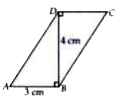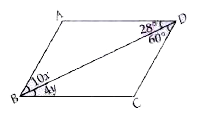ABCD is a cyclic parallelogram. The angle is equal to :
The correct Answer is:D
To solve the problem of finding the angle ∠B in the cyclic parallelogram ABCD, we can follow these steps:
Step 1: Understand the Properties of a Cyclic Parallelogram
A cyclic parallelogram is a quadrilateral that is both a parallelogram and inscribed in a circle. This means that all its vertices lie on the circumference of the circle.
Hint: Recall that a cyclic quadrilateral has specific properties related to its angles.
Step 2: Identify the Properties of a Parallelogram
In a parallelogram, opposite sides are equal, and opposite angles are equal. Therefore, we have:
- AB=CD
- AD=BC
- ∠A=∠C
- ∠B=∠D
Hint: Remember that in a parallelogram, opposite angles are equal.
Step 3: Use the Property of Cyclic Quadrilaterals
For any cyclic quadrilateral, the sum of opposite angles is 180∘. Thus, we can write:
∠A+∠C=180∘
Since ∠A=∠C, we can substitute:
∠B+∠D=180∘
Hint: Use the property of cyclic quadrilaterals to relate the angles.
Step 4: Substitute the Equal Angles
Since ∠B=∠D (as established from the properties of the parallelogram), we can substitute ∠D with ∠B:
∠B+∠B=180∘
This simplifies to:
2∠B=180∘
Hint: Combine like terms to simplify the equation.
Step 5: Solve for ∠B
Now, divide both sides by 2 to find ∠B:
∠B=180∘2=90∘
Hint: Perform the final calculation to find the measure of the angle.
Conclusion
Thus, the angle ∠B in the cyclic parallelogram ABCD is 90∘.
Final Answer: ∠B=90∘
A cyclic parallelogram is a quadrilateral that is both a parallelogram and inscribed in a circle. This means that all its vertices lie on the circumference of the circle.
In a parallelogram, opposite sides are equal, and opposite angles are equal. Therefore, we have:
- AB=CD
- AD=BC
- ∠A=∠C
- ∠B=∠D
For any cyclic quadrilateral, the sum of opposite angles is 180∘. Thus, we can write:
∠A+∠C=180∘
Since ∠A=∠C, we can substitute:
∠B+∠D=180∘
Since ∠B=∠D (as established from the properties of the parallelogram), we can substitute ∠D with ∠B:
∠B+∠B=180∘
This simplifies to:
2∠B=180∘
Now, divide both sides by 2 to find ∠B:
∠B=180∘2=90∘
Thus, the angle ∠B in the cyclic parallelogram ABCD is 90∘.
Topper's Solved these Questions
- BOOK - KIRAN PUBLICATIONCHAPTER - GEOMETRYEXERCISE - QUESTIONS ASKED IN PREVIOUS SSC EXAMS (TYPE- XI)22videos
GEOMETRY
- BOOK - KIRAN PUBLICATIONCHAPTER - GEOMETRYEXERCISE - QUESTIONS ASKED IN PREVIOUS SSC EXAMS (TYPE- XII)90videos
GEOMETRY
- BOOK - KIRAN PUBLICATIONCHAPTER - GEOMETRYEXERCISE - QUESTIONS ASKED IN PREVIOUS SSC EXAMS (TYPE-IX)5videos
GEOMETRY
- BOOK - KIRAN PUBLICATIONCHAPTER - DISCOUNTEXERCISE - Test Yourself10videos
DISCOUNT
- BOOK - KIRAN PUBLICATIONCHAPTER - LCM AND HCF EXERCISE - Test Yourself18videos
LCM AND HCF
Similar Questions
Knowledge Check
- Question 1 - Select One
If ABCD is a cyclic parallelogram , then the ∠A is .
यदि ABCD एक चक्रीय समांतर चतुर्भुज है, तो ∠A क्या है?A100∘B60∘C80∘D90∘ - Question 2 - Select One
In the adjoining figure, ABCD is a parallelogram. Then its area is equal to
 A9 cm2B12 cm2C15 cm2D36 cm2
A9 cm2B12 cm2C15 cm2D36 cm2 - Question 3 - Select One
If ABCD is a cyclic quadrilateral, then cosA+cosB is equal to
A0BcosC+cosDC−(cosC+cosD)DcosC−cosD
In a parallelogram if each angle is equal then it is called a
View SolutionABCD is a parallelogram . If ∠A+∠C=120∘, then ∠B+∠D=________
View SolutionABCD is a parallelogram, if the two diagonals are equal, find the measure of ∠ABC.
View SolutionIf ABCD is a parallelogram with two adjacent angles ∠A=∠B then the parallelogram is a
View SolutionIn the given figure, ABCD is a parallelogram, then ∠DBAand∠BDA are respectively equal to
 View Solution
View Solution


